Cold pork. Gnocchi. Cabbage salad. Fried potatoes. The way Meliora names its dishes, one could mistake them for the titles of paintings from some laconic artist’s latest still life series. Or, perhaps a bit closer to the truth, co-owner and executive chef Drew Adams was too deep down the rabbit hole, too utterly fixated in search of the sublime, that he simply couldn’t be bothered coming up with something more descriptive than each dish’s working title. By the time a diner digs into one of the restaurant’s plates, both assertions seem plausible.
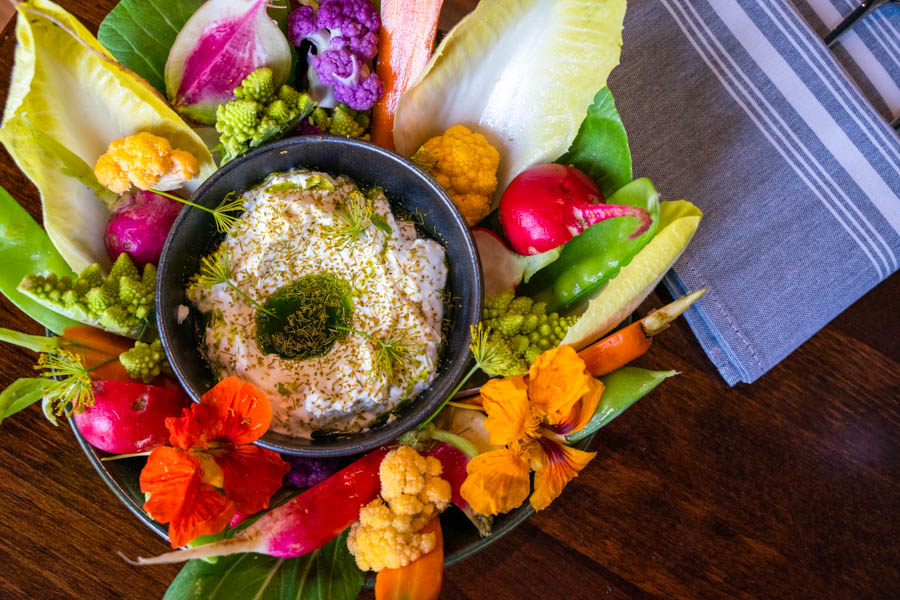
The new restaurant on Hillview—co-owned by Washington D.C. transplants Chef Adams and longtime friend/associate Bruce Pike—brings an extraordinary level of artistry into the flavor profile and presentation of their New American tapas-style menu, a tweezer-wielding approach to perfection that is as playfully obfuscated by the unassuming verbiage of the menu as the understated décor. Inside, a simple palette of dark blue and minimalist fixtures, with here and there an accent color or framed illustrations of fishes, serves as a comfortable but unobtrusive backdrop for an ambitious body of work.

MELIORA, 1920 HILLVIEW STREET, SARASOTA, 941-444-7692, MELIORARESTAURANT.COM, @MELIORARESTAURANT
That body of work—and an introduction to a recurring theme of using locally sourced product—might begin with something from their cold selections like the ricotta with seasonal vegetables. The vegetables come from a cross section of farms in the region and in spring might include wild carrots, radishes, purple and yellow cauliflower, edible flowers and Romanesco, the latter striking with its fractals. In the center of it all, a bowl of whipped ricotta cheese seasoned heavily with dill. The vegetables are halved or quartered, with a light spritz of white balsamic and a pinch of salt. Plated with an eye for composition and color, it’s a simple, shareable appetizer that celebrates organic farming as much as it does culinary arts.
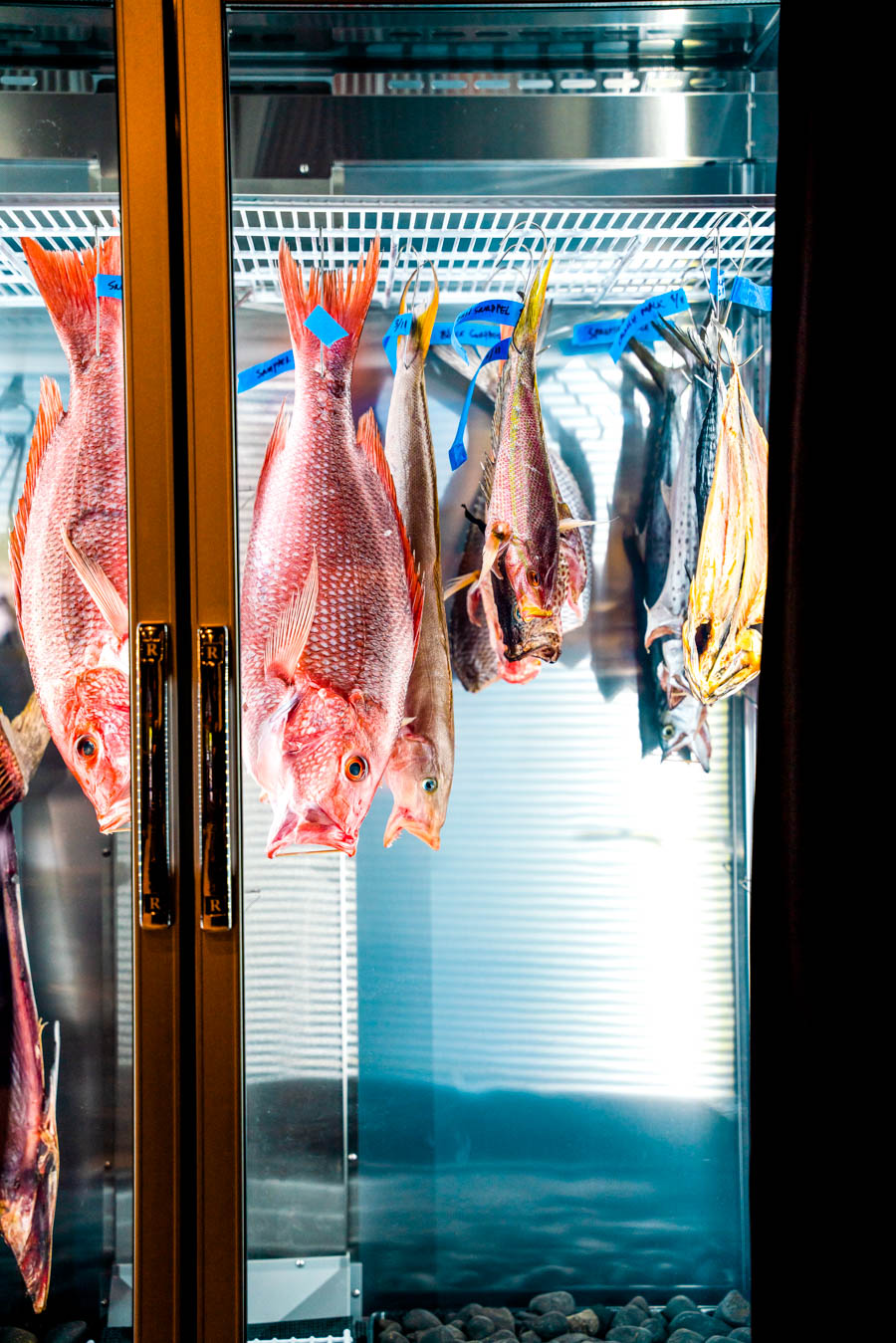
The cold pork impresses with a balance of sweet, savory and a touch of spice in the form of chili oil. Based on a Szechuan dish, it features ground pork cooked in a soy, fish sauce and sesame base. Served with verdant romaine lettuce leaves from Homestead Hydroponic farm, these cold pork lettuce wraps are best enjoyed with a drizzle of the spicy chili oil, which cuts through the pork with just the right amount of heat. The dish thrives as a shareable plate much like the vegetable platter. A beet salad further establishes the visual panache of the menu. Listed on the “warm” half of the menu, it comes with a creamy whipped goat cheese at the base, as well as grilled avocado and Italian vin. Characteristically earthy and surprisingly dense, the dish’s “wow” moment comes courtesy of its presentation, which sees the whole plate sculpted into something of an abstract homage to the color purple.
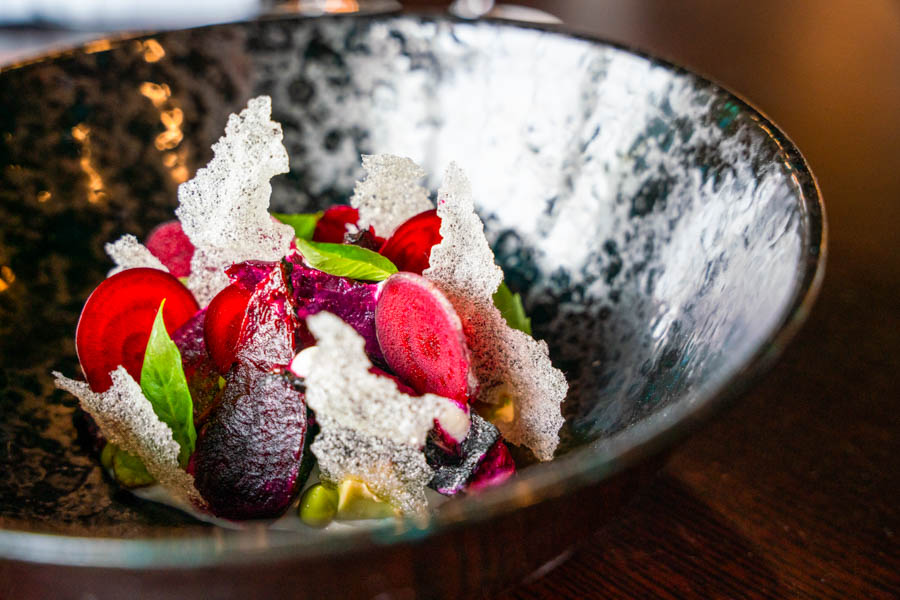
A COMMITMENT TO SEASONALITY MEANS THIS EARTHY BEET SALAD IS AVAILABLE THROUGH EARLY SPRING.
For co-owner Bruce Pike, who manages the front of house, dishes like the vegetable platter, cold pork or beet salad make his job of securing positive feedback a simple one. But as the menu gets into the more ambitious platings, the ones that showcase Adams’ impressive experience in prestigious D.C.-area kitchens—including three Michelin-starred restaurants—diners might find themselves lost in a trance of pure culinary pleasure. And the path to that pleasure is paved with Meliora’s carbonara. Historically made as a peasant food, a traditional carbonara maximizes the calories-to-cost ratio with copious amounts of cheese, egg and pork fat. What Meliora has done with its take on the dish is elevate it with rarified ingredients, namely duck eggs. Slightly larger than chicken eggs, duck eggs also contain a bit more fat and a more intense, creamy texture. That means a smaller serving of duck eggs packs more egginess into less space. Finished with shavings of cured duck egg, Chef Adams also smokes the dish’s guanciale in house for 24 hours, which combines with the dash of black pepper to turn this decidedly un-peasantly preparation into something more. Rich, smokey, peppery, exploding with umami—the carbonara induces the kind of closed-eye experience reserved for moments of bliss.
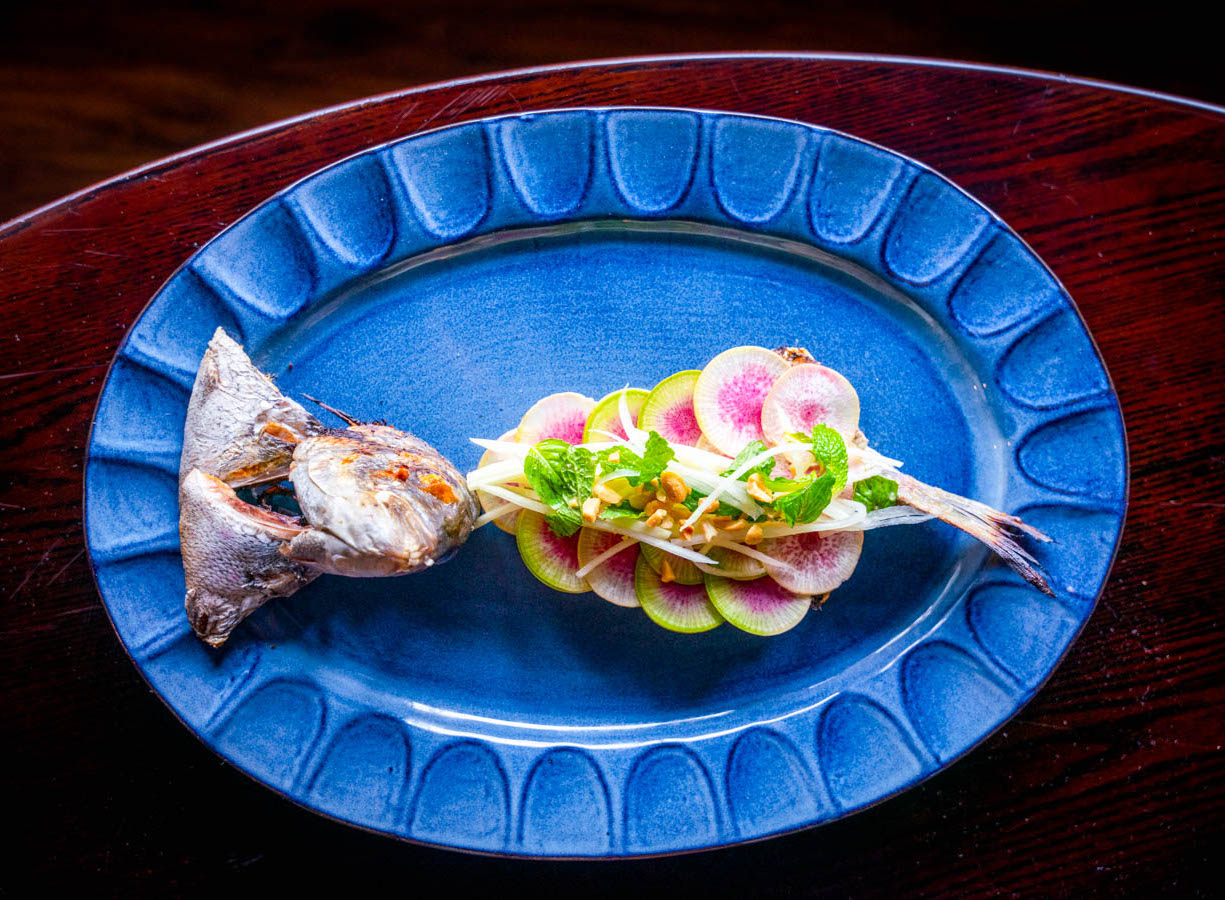
THE SHEEPSHEAD SPECIAL SEES CHEF ADAMS EXPERIMENT WITH NEW FISH.
Another of Chef Adams’ masterpieces—one that was 14 years in the making according to Adams—is the scallop crudo. The dish centers on thinly sliced pieces of raw scallop garnished with a bit of chive and basil, including the little basil flowers. The final flourish includes a pour of warm scallop cream. As for flavor profile, the small dish expresses rather loudly an allusion to the rich chowders of Adams’ and Pike’s Mid-Atlantic roots, with a potent first wave of brine accenting a steady tide of creaminess.

UNDERSTATED DECOR SERVES AS A BLANK CANVAS FOR BEAUTIFUL PLATINGS.
The drink menu, which rotates as frequently as the food, features an eclectic assortment of craft cocktails from the imagination of Topher Nalefski, who the mixologically inclined might know well from his successful run at State Street Eating House and Cocktails. If Nalefski hasn’t already departed too far from the time traveler’s wife, his take on a negroni, a thirsty diner might enjoy the dash of black pepper, splash of sparkling water and sprig of mint. Less bitter than a traditional negroni, the cocktail nonetheless warrants a moderate sipping pace.

One of the great benefits of a tapas-style menu is that no single dish, particularly if shared, will leave a diner filled to the brim. This leaves just enough room for dessert, which at Meliora means the food starts to look increasingly like works of art. A plating of frozen white polenta pipings with delicate vanilla meringue discs between them comes drizzled with strawberry syrup, then embellished with buttermilk drops. The buttermilk remains separate from the syrup, giving the dessert its spotted look. More importantly, the immense amount of sweetness never dominates what is a broad and balanced cornucopia of flavors.
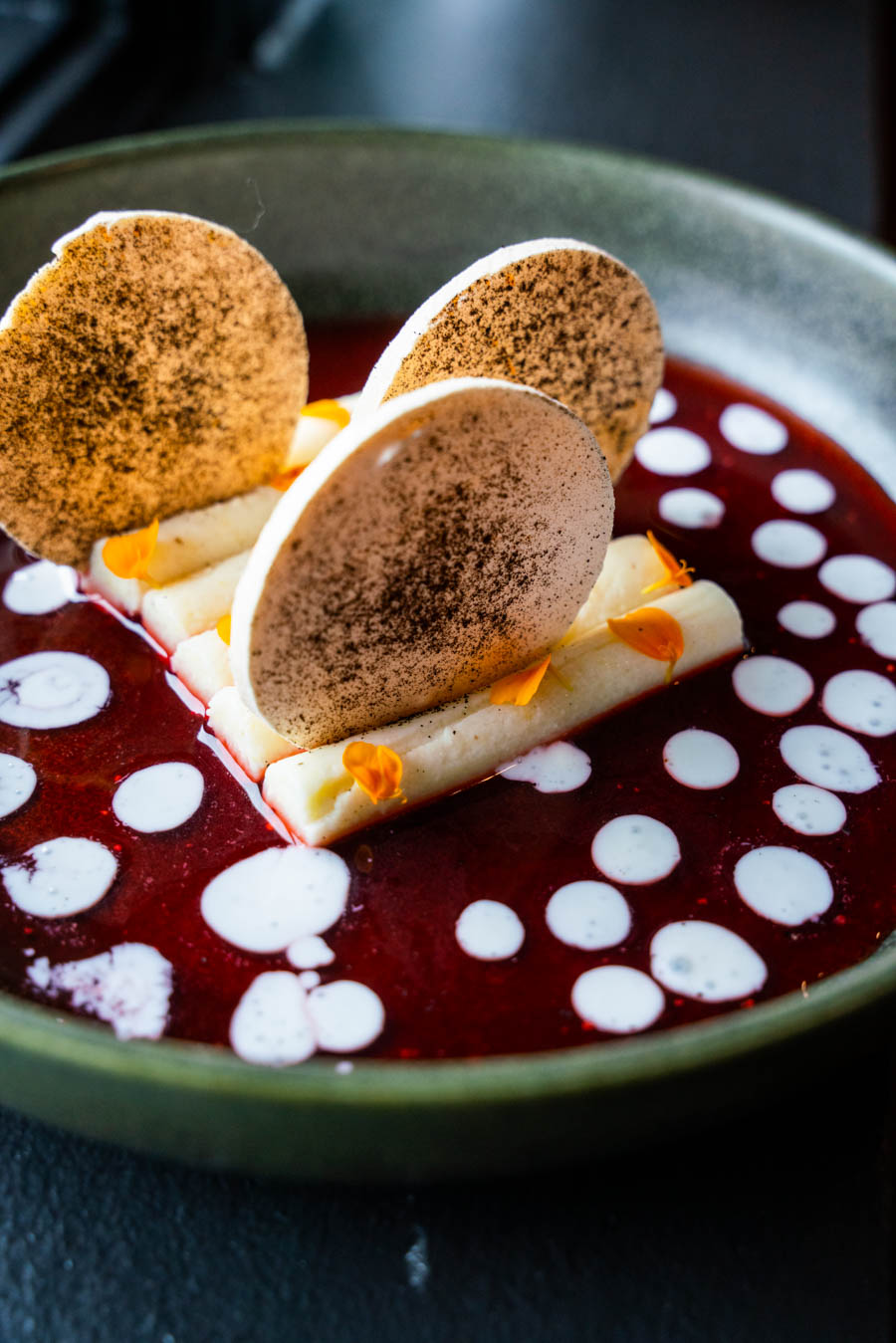
A REFRESHINGLY SURPRISING BLEND OF HOUSEMADE STRAWBERRY SYRUP, BURNT LEMON, VANILLA MERINGUE AND POLENTA MAKE THIS DESSERT MORE THAN A SWEET TREAT.
Those lucky enough to be invited to the custom wood slab counter that is the chef’s table overlooking the kitchen, will find themselves feeling almost like they’ve stepped into some prolific artist’s studio. As Chef Adams roams his kitchen, he ponders a sauce pan here, deliberates over a stock pot there, grabs his tweezers and toils over a garnish the way a painter might agonize over the way light reflects off their subject’s eye. In Meliora’s seemingly simple dishes, we find great imagination and technique, a mastery of the tried and true with an eye for the new and bold. Indeed, we find great artistic skill, none more refined than the art of the undersell.









